The One Draft Mode enforces only one draft per published diagram. Thus, preventing multiple drafts of the same diagram being edited at the same time.
To enable the One Draft Mode in Evolve Designer:
Start Evolve Designer.
On the Evolve Designer Models launcher dialog box, click the Configure Evolve Server button.

The Evolve Server Configuration dialog opens.
Under Features, select the Enable One Draft Mode check box.
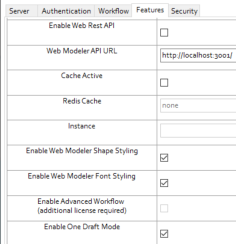
Click Save.
Click Configure IIS and perform full deployment.
This enables the One Draft Mode. Once it is enabled:
The “Available drafts for this diagram” option is disabled.
Clicking the Edit Diagram In Web Modeler icon bypasses the “Available draft for this diagram” option and redirects you to erwin Web Modeler.
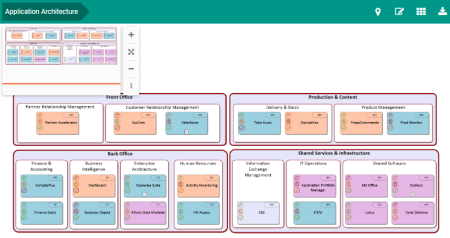
The “Duplicate Draft” option in erwin Web Modeler is disabled.
Clicking 
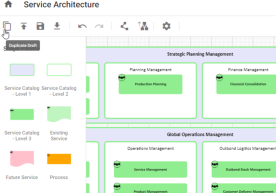

The “Create new draft” button is disabled.
If a diagram has more than one draft diagram created prior to the setting being enabled, clicking Create new draft, displays a notification, “Unable to create a draft because single draft mode is enabled.”
You can delete unwanted drafts. Once done, you will be redirected to erwin Web Modeler.
|
|
If the diagram already has a draft created, and someone modifies the published diagram via the desktop modeler, then beware that any changes made in the published diagram won't be synchronized in the draft diagrams. To see the changes, delete the unwanted drafts and create a new one. |
|---|
The Padlock Objects feature enables you to lock and unlock objects in Web Modeler.
To lock the objects on the diagram surface, follow these steps:
Select the required object you want to lock. For example, Syscom.
The Lock selected nodes option is enabled.
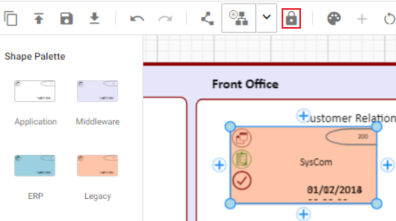
Click 
A Syscom object is now locked.
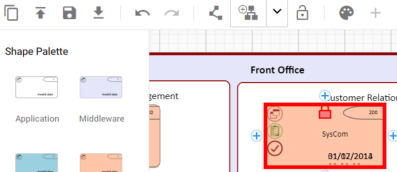
|
|
A locked object cannot be moved on the canvas, but its properties can be edited. |
|---|
Similarly, you can unlock an object. To unlock an object, select the object and click 
|
|
Selecting unlocked objects displays Selecting only locked items displays |
|---|
Previously if you wanted to use Web Modeler you were restricted to a single server installation. We have now extended the configuration to allow for multi-server (or load balanced) environments.
This topic explains the process to configure MongoDB Replication. This process is only required if you are serving Evolve Web Platform from more than one web server, in a load balanced array.
Configure MongoDB Replication
Press the Windows key and then click Start.
Search for Services.
The Services window appears.
Select MongoDB Server.
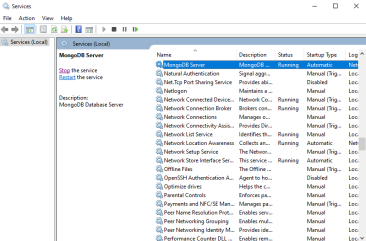
Click Stop.
MongoDB Server service stopped.
Go to MongoDB bin folder available at C:\Program Files\MongoDB\Server\4.2\bin.
Open `mongod.cfg` file in text editor (For example, Notepad).
Update replication property as follows:
replication:
replSetName: "rs0"
Bind your system IP address in the following format:
net:
port: 27017
bindIp: <enter system ipv4>, 127.0.0.1
Save the`mongod.cfg` file.
Start MongoDB Service.
Go to C:\Program Files\MongoDB\Server\4.2\bin and open the command Prompt.
Run the mongo.exe command.
Run the following command:
rs.initiate({_id : "rs0",members: [{ _id: 0, host: "<enter system ipv4>:27017"}]})
|
|
The default MongoDB port number is 27017. If required, you can update it to a different port number. |
|---|
Run the rs.status() command to check whether replication is configured successfully.
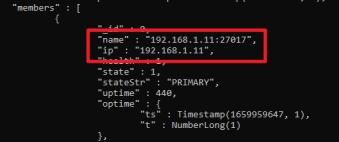
Successful MongoDB replication is indicated by a response where the members array has the name and IP properties according to the values configured in step 13.
The instructions below explain Evolve Server Configuration to publish your sites on it.
On the main/master server:
Start Evolve Designer.
On the Evolve Designer Models launcher dialog, click the Configure Evolve Server button.

The Evolve Server Configuration dialog opens.
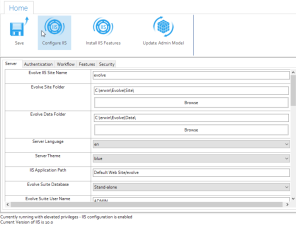
Under Server, select the Primary Server, Share Data Folder and Share MongoDB check boxes.
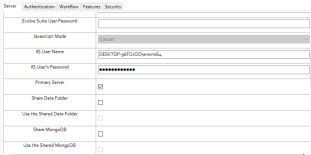
|
|
In the MongoDB URL option, the IPv4 address will be replaced with the host address, unless you manually update the main machine IP address. |
|---|
Click Save.
Click Configure IIS and perform full deployment.
On the secondary server:
Start Evolve Designer.
On the Evolve Designer Models launcher dialog, click the Configure Evolve Server button.

The Evolve Server Configuration dialog opens.

Under Server, select the Use the Share Data Folder and Use the Shared MongoDB check boxes.
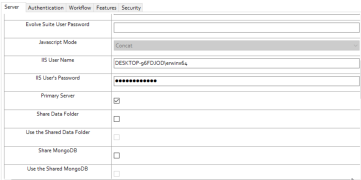
Click Features and in the Web Modeler API URL box, replace your host IP address with "localhost".
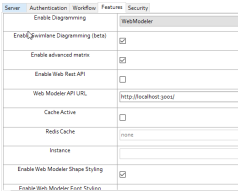
|
|
The address should be “http://localhost:3001/” after replacing IP address. |
|---|
|
|
Before deploying, ensure that MongoDB and Diagrammer services are running. |
|---|
Click Save.
Click Configure IIS and perform full deployment.
|
|
Verify whether the database property is added to the environment variables. |
|---|
Restart the secondary server.
Open erwin Web Modeler.
Verify whether it displays the main server’s erwin Web Modeler drafts and data. This indicates that both machines are connected to the same MongoDB database.
Previously if you wanted to use Web Modeler you were restricted to a single server installation. We have now extended the configuration to allow for multi-server (or load balanced) environments.
This topic explains the process to configure MongoDB Replication. This process is only required if you are serving Evolve Web Platform from more than one web server, in a load balanced array.
Configure MongoDB Replication
Press the Windows key and then click Start.
Search for Services.
The Services window appears.
Select MongoDB Server.

Click Stop.
MongoDB Server service stopped.
Go to MongoDB bin folder available at C:\Program Files\MongoDB\Server\4.2\bin.
Open `mongod.cfg` file in text editor (For example, Notepad).
Update replication property as follows:
replication:
replSetName: "rs0"
Bind your system IP address in the following format:
net:
port: 27017
bindIp: <enter system ipv4>, 127.0.0.1
Save the`mongod.cfg` file.
Start MongoDB Service.
Go to C:\Program Files\MongoDB\Server\4.2\bin and open the command Prompt.
Run the mongo.exe command.
Run the following command:
rs.initiate({_id : "rs0",members: [{ _id: 0, host: "<enter system ipv4>:27017"}]})
|
|
The default MongoDB port number is 27017. If required, you can update it to a different port number. |
|---|
Run the rs.status() command to check whether replication is configured successfully.

Successful MongoDB replication is indicated by a response where the members array has the name and IP properties according to the values configured in step 13.
The instructions below explain Evolve Server Configuration to publish your sites on it.
On the main/master server:
Start Evolve Designer.
On the Evolve Designer Models launcher dialog, click the Configure Evolve Server button.

The Evolve Server Configuration dialog opens.

Under Server, select the Primary Server, Share Data Folder and Share MongoDB check boxes.

|
|
In the MongoDB URL option, the IPv4 address will be replaced with the host address, unless you manually update the main machine IP address. |
|---|
Click Save.
Click Configure IIS and perform full deployment.
On the secondary server:
Start Evolve Designer.
On the Evolve Designer Models launcher dialog, click the Configure Evolve Server button.

The Evolve Server Configuration dialog opens.

Under Server, select the Use the Share Data Folder and Use the Shared MongoDB check boxes.

Click Features and in the Web Modeler API URL box, replace your host IP address with "localhost".

|
|
The address should be “http://localhost:3001/” after replacing IP address. |
|---|
|
|
Before deploying, ensure that MongoDB and Diagrammer services are running. |
|---|
Click Save.
Click Configure IIS and perform full deployment.
|
|
Verify whether the database property is added to the environment variables. |
|---|
Restart the secondary server.
Open erwin Web Modeler.
Verify whether it displays the main server’s erwin Web Modeler drafts and data. This indicates that both machines are connected to the same MongoDB database.